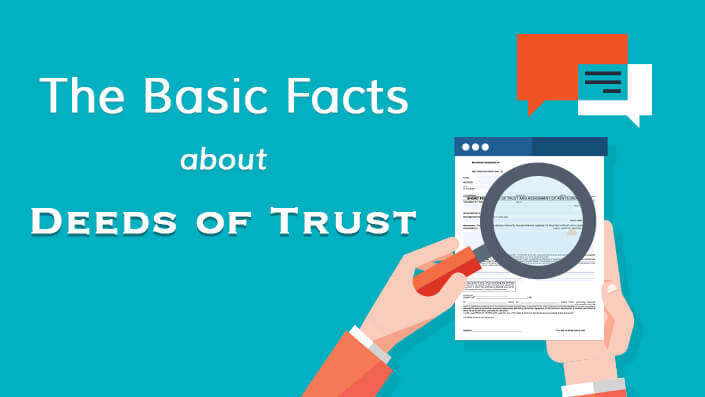
The Basic Facts About Deeds of Trust
Deed of Trust or “Trust Deed”, is the document that secures a loan on a piece of property. The Deed of Trust and the secured Note go hand-in-hand and the Deed of Trust is not valid without the Note. (Check our Notes page for all the basic facts)
In an escrow transaction, the Escrow Holder may be requested to prepare the Trust Deed together with the Note if the Lender is a private party who does not have the forms or the expertise to do so.
Be sure you consult with your legal counsel once these forms are prepared.
There are two basic types of Deeds of Trust, the Long Form and the Short Form. The Long Form, which could be 20-30 pages long, is the one used by institutional lenders. The Short Form is the one that is most usually prepared by your Escrow Officer. The reason it is “Short” is because the clauses and conditions that appear as standard in the Long Form are incorporated in one document and recorded in all the California counties. By referencing the recorded instrument numbers on the document, the Short form assures that all the rights and obligations of the parties under law and as shown on the Long Form are preserved.
There are three parties, all of which have to be legal entities **, in a Deed of Trust drawn up according to California’s laws:
- The “Trustor” is the person who borrowed the money (the Payor of the Note)
- The “Beneficiary” is the person who is lending the money (the Payee of the Note)
- The “Trustee” is the neutral 3rd party who will issue the release of the loan once it is paid in full
** Legal entity – an entity whose existence is recognized under State and Federal laws. Example – a natural person or an incorporated organization. Not a legal entity – dbas, Fido, your French poodle.
Whichever type of Deed of Trust is being used there are certain requirements that must be incorporated into this instrument. It must:
- Be in writing
- Have an amount which matches the amount on the Note(s)
- Have a date which matches the date on the Note(s)
- Have a complete legal description of the property(s) being encumbered (street address only is not sufficient)
- Have the name of the Beneficiary and it must match exactly the name of the Payee on the Note(s)
- Have the name of the Trustor and it must match exactly the name of the Payor on the Note(s)
- Have the name of the Trustee and the name must match exactly the name of the Trustee on the Note(s)
- Have an address for the Trustor for mailing notices in case of default
- Have a good return address for Beneficiary for mailing the document back after recording
- The instrument must be signed by the Trustor and notarized
If there are certain conditions that have been negotiated between parties and incorporated into the Note, some of them also have to appear on the Deed of Trust to give constructive notice. Those are:
- Due on sale clause – the loan must be paid in full if property transfers ownership
- Subordination clause – allows this loan to be subordinated to a new loan to be made in the future
- Partial Release provisions – partial reconveyance in the event of partial payoff
- Cross collaterization – for loans that are secured on more than one piece of property
Like the Note, the Escrow Officers may prepare the Deed of Trust but it is up to the client to obtain their own independent legal counsel to review the final documents to make sure that they properly reflect the agreement between all parties.
The Short Form Deed of Trust form can be found on our website under our Forms section.
It is important that you seek your legal and financial counsel with respect to all conditions and preparation of the Note and the Deed of Trust, in and outside of an escrow transaction.
First question: “What is a Note?”

Juliana Tu, CSEO, CEO, CBSS, CEI, SASIP
Escrow Manager

Good news! “The Art of Escrow” is out! Look for it on www.amazon.com!

The Art of Escrow:
The Fight For Your American Dream and the Pursuit of Homeownership
Available now at Amazon.com
- Threats to Escrow – Part 5 – Document Fraud! - May 19, 2023
- When the Loan Got Sold and You Just Closed Escrow - April 6, 2020
- Mechanics Lien - October 7, 2019
- Are You a Foreigner and Need to Know About U.S. FIRPTA Withholding Laws? - February 20, 2019
- When the FIRPTA
Withholding Goes Wrong - February 20, 2019
Join Our FREE Viva Escrow Forums
